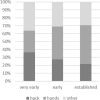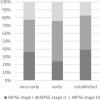Pain chronification and the important role of non-disease-specific symptoms in patients with systemic sclerosis
- PMID: 33468227
- PMCID: PMC7816465
- DOI: 10.1186/s13075-021-02421-1
Pain chronification and the important role of non-disease-specific symptoms in patients with systemic sclerosis
Abstract
Background: Pain is a frequent, yet inadequately explored challenge in patients with systemic sclerosis (SSc). This study aimed to conduct an extensive pain assessment, examining pain chronification and its association with disease manifestations.
Methods: Consecutive SSc patients attending their annual assessment were included. SSc-specific features were addressed as defined by the European Scleroderma Trials and Research (EUSTAR) guidelines. Pain analysis included intensity, localization, treatment, chronification grade according to the Mainz Pain Staging System (MPSS), general well-being using the Marburg questionnaire on habitual health findings (MFHW) and symptoms of anxiety and depression using the Hospital Anxiety and Depression Scale (HADS).
Results: One hundred forty-seven SSc patients completed a pain questionnaire, and 118/147 patients reporting pain were included in the analysis. Median pain intensity was 4/10 on a numeric rating scale (NRS). The most frequent major pain localizations were hand and lower back. Low back pain as the main pain manifestation was significantly more frequent in patients with very early SSc (p = 0.01); those patients also showed worse HADS and MFHW scores. Regarding pain chronification, 34.8% were in stage I according to the MPSS, 45.2% in stage II and 20.0% in stage III. There was no significant correlation between chronification grade and disease severity, but advanced chronification was significantly more frequent in patients with low back pain (p = 0.024). It was also significantly associated with pathological HADS scores (p < 0.0001) and linked with decreased well-being and higher use of analgesics.
Conclusions: Our study implies that also non-disease-specific symptoms such as low back pain need to be considered in SSc patients, especially in early disease. Since low back pain seems to be associated with higher grades of pain chronification and psychological problems, our study underlines the importance of preventing pain chronification in order to enhance the quality of life.
Keywords: Chronification; Non-disease-specific symptoms; Pain; Systemic sclerosis.
Conflict of interest statement
OD: consultancy relationship and/or received research funding (last 3 years) from Abbvie, Actelion, Acceleron Pharma, Amgen, AnaMar, Baecon Discovery, Blade Therapeutics, Bayer, Boehringer Ingelheim, Catenion, Competitive Drug Development International Ltd., CSL Behring, ChemomAb, Curzion Pharmaceuticals, Ergonex, Galapagos NV, Glenmark Pharmaceuticals, GSK, Inventiva, Italfarmaco, iQone, iQvia, Lilly, medac, Medscape, Mitsubishi Tanabe Pharma, MSD, Novartis, Pfizer, Roche, Sanofi, Target BioScience and UCB in the area of potential treatments of scleroderma and its complications. In addition, OD has a patent mir-29 for the treatment of systemic sclerosis issued (US8247389, EP2331143).
PH: speaker fee: Grünenthal Pharma AG, Nevro Medical Ltd.
CM: Consultancy fees from Boehringer-Ingelheim and mepha, as well as congress support from Roche and Actelion.
RD: grants from Articulum Fellowship, sponsored by Pfizer (2013-2014), and Actelion; speaker fees from Actelion and consultancy fees from Boehringer-Ingelheim in the field of systemic sclerosis, outside the submitted work.
BM: grant/research support from AbbVie, Protagen and Novartis Biomedical Research and speaker fees from Boehringer-Ingelheim as well as congress support from Pfizer, Roche, Actelion, mepha and MSD. In addition, BM has a patent mir-29 for the treatment of systemic sclerosis issued (US8247389, EP2331143).
Figures


Similar articles
-
[Success of treatment in higher stages of pain chronification as well? An evaluation of the Mainz pain staging system based on the QUAST-analysis sample].Schmerz. 2011 Feb;25(1):77-88. doi: 10.1007/s00482-010-0999-7. Schmerz. 2011. PMID: 21264477 German.
-
[Staging of pain in patients with chronic low back pain in inpatient rehabilitation: validity of the Mainz Pain Staging System of pain chronification].Schmerz. 2009 Apr;23(2):154-65. doi: 10.1007/s00482-008-0743-8. Schmerz. 2009. PMID: 19082637 German.
-
Association between cortisol levels and pain threshold in systemic sclerosis and major depression.Rheumatol Int. 2018 Mar;38(3):433-441. doi: 10.1007/s00296-017-3866-3. Epub 2017 Oct 30. Rheumatol Int. 2018. PMID: 29086069
-
[How can I assess the back pain status in my patients? The Mainz chronic disease staging method and its prognostic value].Z Orthop Ihre Grenzgeb. 2005 May-Jun;143(3):311-5. doi: 10.1055/s-2005-836634. Z Orthop Ihre Grenzgeb. 2005. PMID: 15977120 Review. German.
-
Quality of life in systemic sclerosis.Autoimmun Rev. 2015 Dec;14(12):1087-96. doi: 10.1016/j.autrev.2015.07.012. Epub 2015 Jul 23. Autoimmun Rev. 2015. PMID: 26212726 Review.
Cited by
-
The frequency and clinical associations of opioid use in systemic sclerosis.Rheumatol Adv Pract. 2024 Nov 15;8(4):rkae144. doi: 10.1093/rap/rkae144. eCollection 2024. Rheumatol Adv Pract. 2024. PMID: 39669116 Free PMC article.
-
Protocol for the development of a tool to map systemic sclerosis pain sources, patterns, and management experiences: a Scleroderma Patient-centered Intervention Network patient-researcher partnership.BMC Rheumatol. 2024 Jun 21;8(1):28. doi: 10.1186/s41927-024-00398-3. BMC Rheumatol. 2024. PMID: 38907303 Free PMC article.
-
Determinants of Depressive Symptoms, Quality of Life, Subjective Health Status and Physical Limitation in Patients with Systemic Sclerosis.Acta Derm Venereol. 2023 Sep 6;103:adv6502. doi: 10.2340/actadv.v103.6502. Acta Derm Venereol. 2023. PMID: 37671777 Free PMC article.
-
Annual trends in pain management modalities in patients with newly diagnosed autoimmune rheumatic diseases in the USA from 2007 to 2021: an administrative claims-based study.Lancet Rheumatol. 2024 Aug;6(8):e518-e527. doi: 10.1016/S2665-9913(24)00120-6. Epub 2024 Jun 27. Lancet Rheumatol. 2024. PMID: 38945137 Free PMC article.
-
Systemic sclerosis. Part I: epidemiology, diagnosis and therapy.BJA Educ. 2023 Feb;23(2):66-75. doi: 10.1016/j.bjae.2022.10.004. Epub 2023 Jan 10. BJA Educ. 2023. PMID: 36686888 Free PMC article. Review. No abstract available.
References
-
- Varga J, Trojanowska M, Kuwana M. Pathogenesis of systemic sclerosis: recent insights of molecular and cellular mechanisms and therapeutic opportunities. J Scleroderma Relat Disord. 2017;2(3):137–152. doi: 10.5301/jsrd.5000249. - DOI
-
- Abraham DJ, Krieg T, Distler J, Distler O. Overview of pathogenesis of systemic sclerosis. Rheumatology (Oxford) 2009;48(Suppl 3):iii3–iii7. - PubMed
MeSH terms
LinkOut - more resources
Full Text Sources
Other Literature Sources
Medical

